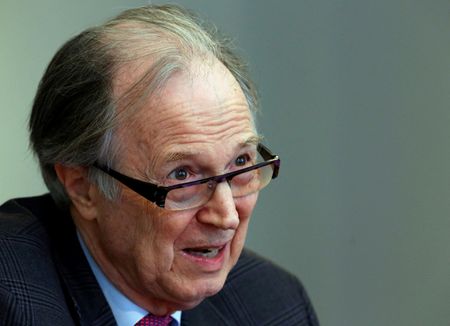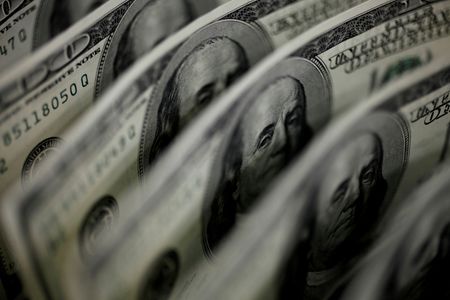By Nell Mackenzie
LONDON (Reuters) – Veteran hedge fund manager John Taylor describes one of his favourite Gary Larson cartoons, where one vulture sitting on an animal carcass says to another as more descend: “good friends flying in from all over…this is the best of times”.
There is, he says jokingly, a resemblance to the hedge funds currently circling foreign exchange markets, where a sudden rise in volatility offers to boost returns for the few specialist investors who survived the decade-long period of calm that forced many from the sector.
Taylor’s former firm, FX Concepts, rode the financial crisis market volatility to its best year in 2008, when assets under management ballooned to over $14 billion, making it the largest currency hedge fund in the world at the time.
But a post-crisis wash of central bank quantitative easing and developed-world interest rates barely above zero sapped the near $7 trillion-a-day global currency markets of the kind of flows that hedge funds thrive on.
The so-called “carry trade” – where investors borrow a low-yielding currency and sell it to buy a higher-yielding one – was wiped out, ultimately leading to the demise of many such specialised funds, including FX Concepts after a run of 35 years.
Now decades-high inflation is forcing central banks to aggressively hike interest rates again.
The U.S. dollar has soared to 20-year highs as the Federal Reserve leads the tightening pack, the yen is at 32-year lows as the Bank of Japan in stark contrast sticks to its ultra-easy policy, and sterling plumbed record lows as government promises of unfunded tax cuts unnerved investors.
Volatility is back, and with it the sort of currency fund performances not seen for years.
Deutsche Bank’s Currency Volatility Index has surged more than 100% so far this year and a BarclayHedge index tracking currency hedge fund performance rose 5.71% in the first half, on track for its best year since 2003.
Similarly, HFR’s HFRI 500 Currency Index, which also tracks these funds, is up 8.29%, its best performance since 2007 and soundly beating the 3.8% rise in a broader hedge fund index.
Unable to resist the opportunities thrown up by the new inflationary environment, Taylor, at 78, has pulled himself out of investment retirement to set about raising the cash he needs to launch a new hedge fund – typically $100 million to $150 million.
The trigger, he said, was listening to Fed Chair Jerome Powell speak on inflation and markets.
“No one has total power over the markets. The market goes where it goes. If he thinks he can (stop inflation and control the market), he’ll make a mistake.”
Big players such as Brevan Howard, which too had a currency fund that fell victim to the post-financial crisis markets, have also upped their focus on forex. Its publicly traded group of funds, BH Macro, more than tripled its FX exposure in the past year and was up 18% at the end of August, according to a recent shareholder report. Brevan Howard declined to comment.
(BarclayHedge currency traders’ index https://fingfx.thomsonreuters.com/gfx/mkt/gdvzyzebepw/BarclayHedge%20currency%20traders%20index%20performance.png)
ONCE BITTEN, TWICE SHY?
The years of muted volatility culled existing currency hedge funds and deterred the creation of new ones, a process which typically takes 7-8 months.
Fund liquidations and consolidations have outpaced inceptions by a significant margin for the last four years, according to BarclayHedge, and no new currency-focused hedge funds have launched this year, a first since the data provider started keeping records in 1990.
(Currency hedge fund launches and closures https://fingfx.thomsonreuters.com/gfx/mkt/xmpjozxqnvr/Hedge%20fund%20launches%20and%20closures.png)
A few stuck it out. BarclayHedge reckons there are now between 85 and 110 such funds, down from 450-550 a decade ago. But they are sitting on $1.3 trillion in assets under management, it notes, the most money entrusted to currency funds by pension funds, asset managers and wealth managers since their records began in 1990.
Still, currency trading is hard, says Record Financial Group CEO Leslie Hill.
Record, which oversees $83.1 billion of assets, has grown to be the biggest currency specialist in the world by hedging the currency risk of asset managers’ more traditional portfolios alongside its own trading strategies.
It has a $4.5 billion currency fund and a $4.4 multi-asset fund, recent public disclosures showed.
“Making a living from pure currency, not just hedging – where the fees are small but the risks are high – but also currency for return…has driven many currency managers out of business,” said Hill.
Adrian Lee, who founded Adrian Lee & Partners in 1999 and manages approximately $17 billion deployed simultaneously as a hedge fund and currency risk management, believes conditions should remain sweet for currency managers.
“Over the last 10 years as a currency manager, if you were offering to add 2% upside to people’s portfolio when they were making 15% on their equities, you wouldn’t get a look in,” he said. “Now the equities part of the portfolio is losing money hand over fist.”
Lee’s returns are running just shy of 20% this year, said a source who could not be identified because of financial regulations.
While Taylor believes a rush of speculators could add to the resurgent volatility, he argues that a recession will bring fresh lows across stocks and some bond and currency markets – hedge funds or not.
Markets reflect the rhythm of a baked-in cycle and traders are there to ride the wave, he said.
(Reporting by Nell Mackenzie; Editing by Kirsten Donovan)


